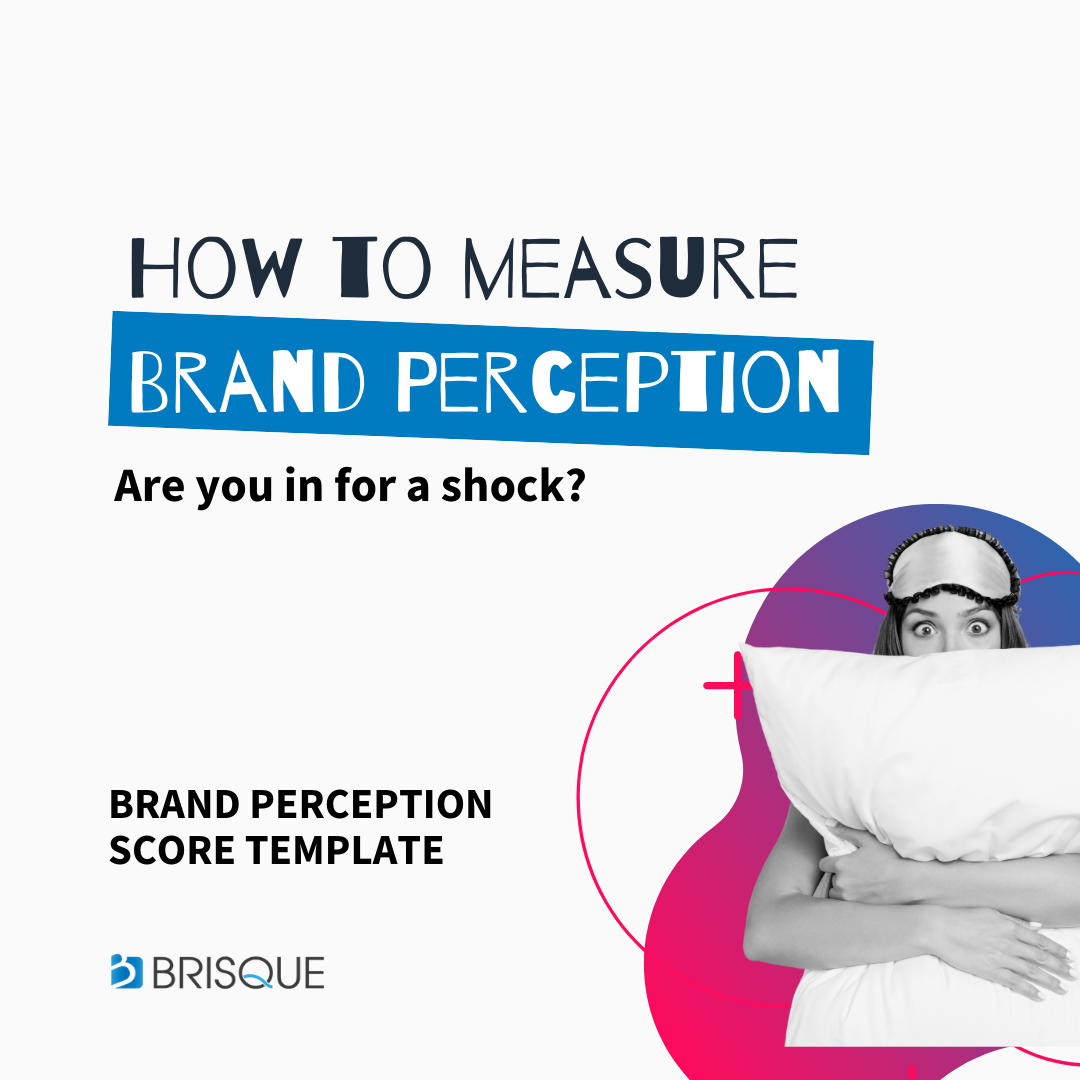Summary
Use this brand perception survey questions and analysis to help you track and measure your brand perception.
Here are the brand perception measurement steps:
- Step 1: Gather Your Brand Perception Data
- Step 2: Categorize Your Unique Brand Identifier
- Step 3: Score Your Brand Perception
What’s your brand perception of Coca-Cola?
How about Volvo?
If you think of any of your favorite products, you’d realize that you have a brand perception.
In the same way, customers will have a perception of your brand. Analyzing your brand perception allows you to confirm whether you are creating the brand experience in the marketplace you want. When you analyze your brand perception, you want to take a data-driven approach.
Your goal with your brand perception analysis process is:
- To identify if your brand perception is the same as what you are creating in the marketplace.
- Ensure that you can use the data you receive to make an informed decision about the direction you’d like to take your brand
- Help you further define your brand differentiator to ensure that you can stand out in the marketplace.
Analyze & Measure Your Brand Perception
STEP 1: GATHER YOUR BRAND PERCEPTION DATA
If you’ve been running your business for years, you may think you have already identified your brand differentiator, which would be right. The more important question is, are you creating that brand you want to create in the marketplace?
The first step is to identify what you want your brand identifier to be and what you don’t want it to be. I covered this in my previous blog post, where I talked about the Brisque marketing messaging workshop exercises.
Note: answer the brand perception questions below before getting any research data. It will help prevent you from having your answers influenced.
Here are the brand perception survey questions to answer:
- Why did I start my company? (hint: it’s not to make money)
- What’s the first thing that I want people to think of when they think of the company or brand?
- What don’t I want them to think of when they think of this company or brand?
Now that you’ve written down your answers, you are ready to gather your customers and employees’ feedback.
Read also: Creative Ways to Track Branding Campaign Success.
Get Brand Perception Feedback from Your Customers
The easiest way to find out what your brand perception is in the marketplace is to ask your customers. You can decide to conduct an online brand perception study (with people opting to give more context) or conduct phone interviews.
Whichever method you choose, make sure that you have enough participants to ensure a decent sample size. Depending on how small or big your organization is, try to get at least 30 participants. If you are smaller and can get about 10, that should be a good start.
I know what you might be thinking: most people hate surveys.
While that’s true, you could offer incentives for people that complete your brand perception survey, including discounts, or sometimes just saying that you need help to improve a customer’s experience is all that it takes to get people to opt in to help.
Additionally, you only need to ask two questions, which makes it easier for people to agree.
Customer brand perception survey questions are:
- Why did you select [Insert Your Company Name]?
- Now that you are a customer with [Insert Your Company Name], what makes you stay with [Insert Your Company Name]?
Related: What is Humanized Marketing?
Get Brand Perception Feedback from Employees
It’s also crucial during the data gathering phase to get information from employees. Employee feedback is essential because your brand is not just about the perception outside your company. For instance, if your goal is to create a brand that prioritizes quality, but your employees often have to cut corners, you won’t create a quality brand experience in the marketplace.
Again, during this step, let’s ask only two questions.
Employee brand perception survey questions:
- Why did you decide to work for [Insert Your Company Name]?
- Why are you still working for [Insert Your Company Name]? (Ask employees to avoid talking about benefits related reasons)
Your Brand Perception vs. Reality
Once you have your data from your surveys, you are now ready to review the data. Here, your goal is to identify if your brand’s perception is the same as the brand perception that your customers and employees have.
Before you start reviewing the data you’ve collected, ensure that you’ve already documented your answers to your brand perception questions. Again, you don’t want a case where you start to think that your brand is everything that your customers say because you don’t have your original thoughts on the subject in place.
Read: How to Evaluate Creative Marketing Strategies or Ideas
STEP 2: CATEGORIZE YOUR DATA
Now, you are ready for the fun part. That is to decide if your brand perception is similar to what people think.
To make this exercise as simple as possible, after answering your questions, spend some time categorizing your answers into three main areas:
- Quality
- Knowledge
- Service
Let’s define each of the three areas.
Quality
Quality refers to if you want a brand to be about providing the highest quality product. It means that compared to your competition, there has to be something that stands out when it comes to the Quality of your work. For instance, if you are a cloud service provider, do you provide the fastest speed? Or do you have a higher uptime guarantee than the others in the industry?
Knowledge
Knowledge refers to if you want a brand perception as an informational source. Creating a brand perception as a knowledgeable source is a bit tricky because even though you may have the knowledge and have the best talent in house, it may not always be evident. As part of your brand strategy, you have to think of ways to bring this to life. If you have in-house experts, ensure that they are at the forefront showing the knowledge and sharing the knowledge. Remember, no one will know that your team is knowledgeable if you don’t share the experience.
Examples of ways to do this is to create a blog, create an informational course that your employees teach, host webinars, publish ebooks, and other informational resources.
Service
Do you pride yourself in providing a higher quality service than anyone else? Then, you have to show it. Amazon is an example of a company that excels at building a customer-centric brand, and we’ve seen this in action by how they keep trying to push the needle with delivery times.
The question that you might be thinking is: why can’t I have all three? Quality, knowledge, and Service.
The truth is every company needs all those three elements; however, when you are thinking of your brand, it’s not about everything that goes into your business. It’s about that one memorable thing that you want people to associate with your company. It’s usually the factor that draws people in to experience everything else that you have to offer. Essentially, your products should be high in quality, you should have a knowledgeable staff by hiring great talent, and your customers should feel like they are top of mind.
But realistically, can you lead with all three? No.
Actually, this is where most businesses tend to get lost. When you want to be everything to everyone, and you end up being no one to anyone.
Read Also: Tips for Marketing Your SaaS Product as a Must-Have
STEP 3: MEASUREMENT: SCORE YOUR BRAND PERCEPTION
Create a Brand Scoring Process for Measuring Your Brand Perception
After categorizing your answers, you can now create a brand perception measurement scoring matrix from the data that you received from both your customers and your employees.
Here’s a sample that I completed for Brisque:
- Why was this company started?
To help companies increase growth by showcasing what’s unique about their business through relatable, easy-to-understand marketing.
- What’s the first thing that I want people to think of when they think of the company or brand?
A go-to place for humanized marketing strategy and resources
- What do I not want people to think of when they think of my company or brand?
Just another marketing company not willing to give you any detailed information unless you pay for it
How to Score Your Brand Perception Answers
Let’s score my answers.
For anything related to Quality, I will put a (Q) for anything pertaining to Knowledge I will put a (K), and for anything related to Service, I will put an (S).
I will strike out the letter for any answers that don’t relate to my main brand category. For instance, if your goal is to create a quality brand perception, you would put (Q) anytime the answer is not related to Quality.
Here’s my grading based on my answers:
- To help technology companies increase growth by showcasing what’s unique about their business through relatable, easy-to-understand marketing (K)
- A go-to place for humanized marketing resources (K)
- Just another marketing company not willing to give you any detailed information unless you pay for it. (K)
As you can see from above, there is a general trend that I’d like the Brisque brand to be known as a knowledgeable resource. So, from the employee and customer data, I can go ahead and score according to this.
Whenever a customer says something related to knowledge, I would mark that cell as (K). For instance, if for the question on why the customer selected Brisque, the answer was, “I was looking for someone to help guide me through marketing decisions” then, I would indicate (K) in corresponding Excel cells. If the answer is not related, I will update the Excel cell as (K). So, in the end, I would end up with an Excel spreadsheet that looks like this:
Sample Brand Perception Scoring for Why Customers Select Your Business
| Customer | Business Selection Desired Brand Attribute | Business Selection Brand Attribute Not Desired |
| Customer A | K | |
| Customer B | K | |
| Customer C | K | |
| Customer D | K | |
| Customer E | K | |
| Customer F | K | |
| Total Count | 4 | 2 |
| Percentage (Brand Score) | 67% | 33% |
Sample Brand Perception Scoring for Why Customers Stay with Your Business
| Customer | Customer Loyalty Desired Attribute | Customer Loyalty Attribute Not Desired |
| Customer A | K | |
| Customer B | K | |
| Customer C | K | |
| Customer D | K | |
| Customer E | K | |
| Customer F | K | |
| Total Count | 3 | 3 |
| Percentage (Brand Score) | 50% | 50% |
You also have to create a similar spreadsheet for your employees’ responses as well. Click here to download the full Excel Template with both customer and Employee data.
Download Free Brand Perception Survey Questions & Measurement Score Excel Template
How to Understand Your Brand Perception Measurement Score
Company Selection Brand Perception Score
As you can see in my fictional example, out of the six customers that answered the brand perception survey, 66% indicated that they selected the company because of my desired brand identifier. Your goal is to get as close to 100% as possible. So, in this case, a good percentage of my customers choose to go with me because of my desired brand perception, but I still have some work to do.
Customer Retention Brand Perception Score
You also want to find out if, after getting a customer, they decide to stay with you because of your desired brand perception. Again, in this fictional example, I switched the scores around. For my desired brand perception when it comes to brand loyalty, I have an even split. You can see that “Customer F” had a different reason why they’ve continuously stayed with the business. I would investigate to find out why their perception has changed. For the customers who chose your business for another reason other than your desired brand identifier of either quality, knowledge, or service, and stay as a customer with Brisque for another reason, you could conclude that you missed the mark entirely your brand messaging.
What does all this mean?
If your goal is for your brand to be known for something, in particular, it has to be seen (through communication with prospective and current clients), and it has to be experienced (through your continued services). When you are doing all of this, and your perception about your brand matches your reality, that means you are doing everything that you can do to ensure that your brand receives the type of recognition that you want.
What if I scored a very low brand perception score?
If you scored a low brand perception score, that means that you have some work to do, but the good news is you’ve taken the first step. You now know that your idea of your brand is different from how others perceive your brand.
Here’s how you want to approach it:
Firstly, take a hard look.
You want to take an honest approach to this; your customers may not perceive your brand like you’d like them to.
The question is, are you that brand, or do you say that you are that brand? Also, sometimes what businesses think is important to customers is different from what’s important to customers.
Customers don’t make purchase decisions just because of what you say. They make purchase decisions because of what they feel. On the one hand, the goal could be to provide a quality technology solution, but on the other hand, your system could have many bugs that disrupt the customer’s user experience more often than not. But whenever they call, you are there to help them, and you take fixing the issue very seriously. To the customer, you are providing excellent customer service, so they see that as your competitive advantage, and that is the brand experience that they feel.
How to Improve Your Brand Perception
Abandon or Fix?
To deliver your desired brand feeling, you have to decide if you’d like to fix or abandon your original brand goal altogether.
When you should adjust your brand perception goal
Sometimes, you start an idea thinking one thing, and then it transforms and shapes into something else.
And that’s okay.
So, if your idea was to be the ‘top-notch quality product’ out there, but your customers are staying with you because of your superb customer experience, you could decide to pivot and make that your brand message and main brand feeling. It’s not to say that you shouldn’t fix your quality issue.
However, it also says that you are already doing a great job at communicating and giving your customers that excellent brand experience so you could choose to amplify that message. If your support team is available 24/7 or develops deeper relationships, so they understand their client’s business, mention that. Perhaps, even make sure that you have customer champions within the company who are only interested in ensuring that customers have a great experience. Or take it a step further and reward employees whenever they have a positive customer experience and share that experience.
When it’s worth the time to fix your brand perception
There are times when pivoting may not also be the best approach. For example, it may be difficult as a Managed IT Services company to not focus on your crucial brand identifier as the customer service you provide. That’s essentially the core of your business. If you find that it doesn’t make sense to switch core brand strategies, you have to develop a plan to ‘put a face’ to your desired brand perception.
By putting a face to it, I don’t mean that you should designate one person who should be the face of your company.
Although that’s not a bad idea!
I mean, you should bring that vision to life in a real tangible way. Again, customers and potential customers will not believe something just because it’s written on your company’s about page. Or a salesperson mentions it a few times.
They will believe it when they can put a face to it.
That means, they can clearly state examples of how the company demonstrated that desired brand perception.
Final thoughts on brand perception measurement
The approach shared above is part of the Brisque brand strategy process. I’ve given you all the information, so why do you need us? Well, for one, the brand perception analysis usually works better when you have a third party who is not associated with your brand involved. It brings in an outside perspective that you may not have otherwise.
We also try to make these exercises as ‘painfully fun’ as possible to get the most information by asking different questions in different ways to get you thinking! Let’s connect.






